- Home
- About
-
Shop
-
Sewing Patterns
-
Fabric
- Sewing Supplies
- Folkwear Clothing
-
- Blog
- Customer Gallery
- Contact
March 03, 2024 7 Comments on 106 Turkish Coat Basics
The 106 Turkish Coat was one of the first patterns released by Folkwear in 1970s. And, it is one of our most popular patterns, as well as a favorite with quilters and clothing artists due to the options for quilting the borders or the entire coat. It is also a great pattern to add artistic fabric panels (since the coat is put together in panels) -- such as a hand-painted back panel or using that special, or handwoven fabric, in the different panels. There is an incredible amount of room for creativity, individuality, and artistry.
This coat originated in Central Asia, where it is made in brilliant silks and floral cottons. It is often made with handwoven and hand-dyed ikat fabrics as well. The borders and cuffs are often made from different fabrics than the body and even the lining or inner borders in different fabrics so there is a beautiful combination of inventive and coordinating fabric throughout the coat. The pattern creates a coat that is boot-length and reversible. Perfect for cool weather of the Central Asian plains.
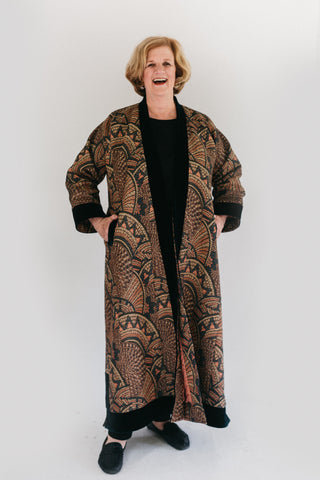
The coat hangs closed in the front without fastenings (though you could add buttons, toggles, frog-and-loop, or ties), and it features a quilted or trapunto border at the hem, neckline, and front opening. The border finish is typically echoed in the cuffs and welts over hand slits, which are common in traditional Turkish outerwear instead of pockets. They are for keeping hands warm, not storing things as pockets would do. The sleeves are roomy and slightly tapered and the coat has underarm gussets and side panels.
Included in this pattern are detailed instructions for trapunto and hand or machine quilting, as well as the designs for all borders and for a decorative square patch at the side hemline (which can be extended over the entire coat if desired). The body of the coat can also be hand or machine quilted.

You can see the quilting in the front borders of this coat.
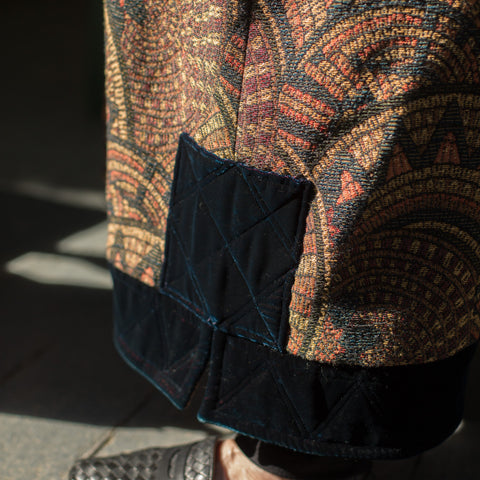
The pattern also includes a lovely simple-sew version of the coat that can be made with pre-quilted fabric. You can even make it as an unlined coat using any kind of fabric with border facings. It would make a fantastic raincoat! And I will show you how to make an unlined version of this coat with some fabulous fabric I found in our stash next week!
Also note that there is no shoulder seam on the coat - the front and back pieces are cut as one. However, if you have a napped fabric or one-directional fabric, you can put in a shoulder seam for the front and back panels and add 1/2" seam allowance.
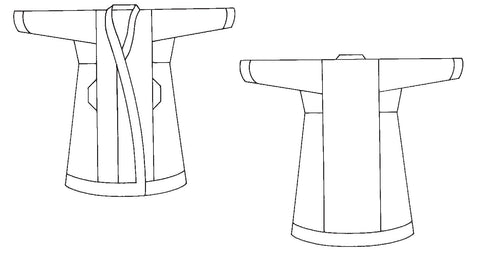
Flat drawings of the front and back of the 106 Turkish Coat. You can see here the different panels that make up the coat - perfect for different fabrics.
The sizing for this pattern is basically small, medium, and large. On the pattern pieces, the sizes are called "slender", "average", and "large". As one of Folkwear's oldest patterns (and similar to other early-Folkwear patterns), the sizing is not conventional since it is based on a traditional garment. There is no sizing chart; there is only a yardage chart. So, I recently made a sizing chart just for this pattern along with the finished measurements (also pictured below). One of the most common requests we get for this pattern is to size it up. However, the original drafting (based on original garments) and instructions does not lend itself to sizing up as we have done for our more recent patterns (such as vintage patterns). The traditional aspect of the pattern pieces and construction of the coat are simple enough to expand sizing on your own. In other words, there are not any curves or odd shaped pieces that need to be graded by a professional to get a larger sized coat. And I will have a tutorial in the next few days to show how to easily increase the size on the coat.
Sizing and Finished measurements chart:



As for fabric, as mentioned before, this is a great coat to use a mix of fabrics. Medium weight fabrics that are soft, such as broadcloth, silk, linen, or a lightweight wool, are all great choices. And, this pattern is great for using special pieces of fabric in the panels, borders, cuffs, etc. Use vintage pieces, handwoven pieces, or those special scraps you've been saving. There are a lot of places to make advantage of creativity in fabric choice.
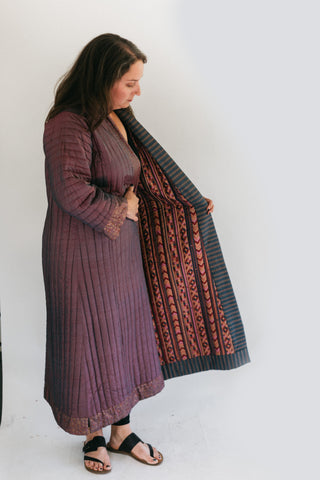
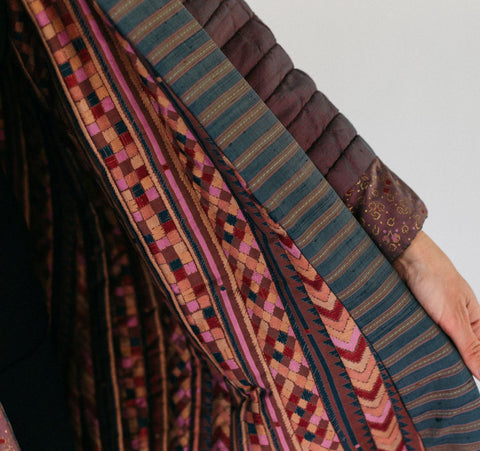
You can see here all the different fabrics that make up this quilted 106 Tukish Coat.
Our 106 Turkish Coat is an incredible pattern - full of detail, full of options, and ready for your creativity! Tell us if you have made this pattern before and what you loved about it (bonus for telling us about the fabric you used and how you made it!).
December 15, 2024
Hi, Thank you for keeping Folkwear Patterns going. I have all of the “vintage” patterns, bought and used in the ’70’s. I have not sewn much in the past 25 or so years, life got in the way, but am thinking of making another coat using Thinsulate as the lining, would I purchase the amount of fabric listed for the lining?
Thanks again, Mary
April 15, 2024
Hi! Mary, yes, using an old quilt would be like doing the pattern with pre-quilted fabric. It would be wonderful!.
Frances, yes, see our post on making an unlined version of this coat here: https://www.folkwear.com/blogs/news/making-an-unlined-106-turkish-coat
If you want it lined, just using the lining pieces also, but do not use batting.
April 03, 2024
Do you think that this pattern would work well using old quilts as the fabric?
March 18, 2024
I’ve made this coat a few times, but never with batting. Batting would DEFINITELY need quilting. I made it as just a fully lined coat, using the same pattern pieces for both shell and lining. It worked out well. My first attempt was with a prequilted double sided fabric practically made for the pattern. My current much-beloved coat is a single layer of cotton canvas, that I did mostly with flat felled seams. I’ve added pockets since my first attempt.
March 17, 2024
I made this coat in 1981. I used a midweight cotton in burgundy for the outside, a printed stripe for the lining (probably poly cotton blend) and I hand quilted the cuffs, neckline, and pocket welts. I used cotton batting because I live in South Dakota and I wanted it heavy. It was wonderful. One of the coldest winters on record and I was warm. Then I washed it and the cotton batting shifted. I still have it but I haven’t worn it since. Thinking I should break out the old pattern and give it another go.
March 17, 2024
I have this pattern and would like to make it in an unquilted version. Do you have any advice on how to go about doing that? Thank you
November 13, 2024 4 Comments on 106 Turkish Coat Basics

Susan Lightcap
December 18, 2024
I made this coat several times using handwoven fabric in the 1990s and was enormously pleased with how well it functioned. In the years since, I lost the pattern and have just bought it again, having found a beautiful Kantha today. I will be adding fabrics that are in the same “spirit” as the Kantha if there’s not enough fabric. As the Kantha is double-sided, I will likely bind the seams on one side with cotton bias binding.